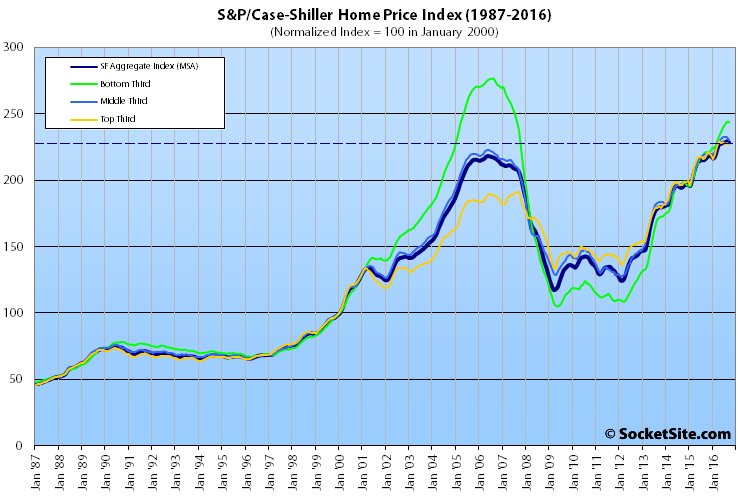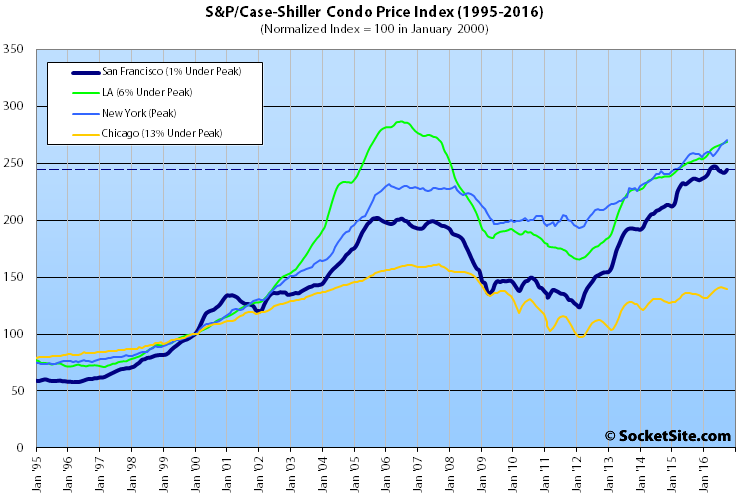While the Case-Shiller Index for single-family home values across the nation gained 0.4 percent from August to September, San Francisco joined Cleveland and Detroit and were the only three major Metropolitan Areas for which the index declined, slipping 0.4 percent, 0.4 percent and 0.1 percent respectively.
That being said, the aggregate index for area single-family homes in San Francisco remains 5.7 percent higher versus the same time last year, which is the smallest year-over-year gain for the region in over four (4) years and versus 6.7 percent higher on a year-over-year basis in August.
The index for San Francisco slipped across all three price tiers in September, dipping 0.2 percent at the bottom end of the market (which remains 11.9 percent below its 2006-era peak), 1.1 percent for the middle (which slipped from 4.5 percent to 3.4 percent higher than its previous era peak), and 0.5 percent at the top-third of the Bay Area market which is still running 18.7 percent above its previous cycle peak circa August 2007 but has slipped from 19.9 percent higher over the past five months.
On a year-over-year basis, the bottom third of the market remains 9.9 percent higher versus 10.7 percent higher the month before while the middle third of the market is running 4.9 percent higher on a year-over-year basis, versus 6.4 percent higher in August, and the top third is 4.7 percent higher versus the same time last year, the smallest year-over-year gain since August of 2012.
At the same time, the index for San Francisco area condo values rebounded 1.1 percent from August to September, it’s first month-over-month gain in four months, and is now running 3.2 percent higher versus the same time last year and 20.9 percent higher than its previous cycle peak in October 2005, down from 22.3 percent higher in May.
And for the seventh month in a row, Portland, Seattle and Denver reported the highest year-over-year gains in the index for single-family homes, up 10.9 percent, 11.0 percent and 8.7 percent respectively, but the pace of gains for all three have slowed.
Our standard SocketSite S&P/Case-Shiller footnote: The S&P/Case-Shiller home price indices include San Francisco, San Mateo, Marin, Contra Costa and Alameda in the “San Francisco” index (i.e., greater MSA) and are imperfect in factoring out changes in property values due to improvements versus appreciation (although they try their best).


hard to beleive prices are still rising, albeit at a much slower clip. The deceleration of appreciation is clear. Is the top near. Surprised to have seen it go so high so fast.
For fun, everyone who is sure that we are headed for a) declines, b) stasis, or c) continued increases should state here the amount of real (i.e. including inflation) delta they expect, and over what time period.
What’s tiresome is bears and bulls just prattling on saying “it’s coming!!” without putting any meat on their predictions. My predictions are for flattening to continue, followed by a real decline of 5 to 20% maximum happening within a 5 year period. Yeah, that’s broad, but I’m taking some kind of stand. Long term, I predict relative stasis after those declines. I predict that the era of huge returns is over for the Bay Area.
We’d suggest adding another key component, which is how you’re going to measure the change. Case-Shiller? (Which is getting a boost from outlying areas) Median sale price? (Which isn’t a great way to measure changes in values) Price per square foot? (Which can be skewed by mix) A bucket of apples-to-apples sales? (Which can be difficult to collect)
Fair enough. I predict a general plateau in prices. Some ups and downs, but no real changes. I’d limit my timeline to two years. Beyond that the uncertainties are too great.
p.s. Trump could throw everything askew. I have no idea how he will govern, as he’s taken about every position on every topic. He’s the wild card.
Agree, the house I bought in the East Bay during the last dip has peaked in value and will bump along until the next rescission. The logical conclusion at my age is I ride it out and sell on the next upswing as long as I move out of Bay Area
Now that Pres Elect Trump has unleashed the elusive animal spirits, it’s hard predicting anything beyond short term, my outlook there is neutral or slow leak depending on the segment. That’s for SF, I see continued strength in the mid range cities. It’s all about the bond yields right now, above 2.6% I would start to worry.
Thank you Frank, well put sir. I also think along with one’s projection they should state their experience or qualifications because let’s face it, my 7 month old daughter’s market projections are not very pertinent.
As a former high volume commercial estate broker (don’t tar me) and a full time multifamily real estate investor, I predict a substantial slide in valuations. By huge slide I mean 25%. Rents will also soften and by huge margins outside of SF proper (central valley, east east bay etc.)
This slide will be caused by a jobless recession and a squeezed highly levered consumer that cannot make things pencil with lofty mortgages and high rent. Oh ya, that and high rates which are coming. Watch for a multifamily crisis when rents soften and rates climb which will not be as bad in SF given the strength of the SF market.
BAM, that was pretty specific.
Ok when?
Before Fesitvus 2017. I’m not just typing it either, I’ve sold most of my properties in the last 12 months.
Fair enough. I suppose we should compare notes in a year, then.
I think that would be fun.
I’m glad everyone is being civil thus far and not insulting each other for divergent beliefs.
It won’t be ‘Trump’ related though, this administration and global central bankers have crushed rates and caused massive asset distortion. It really is that simple. Didn’t need my Ivy league Econ degree to qualify that one.
What rate hikes? Janet Yellen’s term has a few more years left and she is not planning to raise rates.
[Editor’s Note: Benchmark Mortgage Rate Hits 16-Month High, Hike Nearly Certain.]
Expectation is that rates will tick higher in December. If there isn’t a recession I’d also expect 2 rate hikes next year. Fed needs to raise rates so they can lower them again and pretend they are doing something when the next recession starts.
The Fed is no longer piloting this ship, the market is in control now.
Huh? Are you familiar with a thing called the bond market?
I’d like to note that India and China make up approximately 34% of the global population while the US is approximately 3.4%.
I think we will plateau for a few years, maybe decline 10% in central SF. But with a few key IPOs (Uber, AirBNB, Pinterest, Palantir) and the billions they will create locally + the wealthy Indian and Chinese consumers that will be minting their fortunes in the near future, I think they will put a floor under our high prices leading to a muted decline.
You will see that as density continues to rise and commute times lengthen, central SF will strengthen and eventually rise further!
And China and Indian are on solid footing right now economically and in terms of housing??
I would however wager that the major price and rent slides will be outside of SF. SF is a rather insulated places in many ways. The rest of the state, not so much. I wouldn’t be surprised if the SF backpedaling is not very pronounced. Outlying areas, look out below.
Mr. Miyagi, when you speak of SF, are you speaking of the entire Bay Area, select parts of the Bay Area, or SF city only?
SF proper, I’ve seen the East Bay historically run a bit more like a glorified Sacramento market before. SF is a special cupcake in terms of real estate in many ways.
Sf condo prices down 10% between dec 2016 and dec 2018. Case schiller upper end